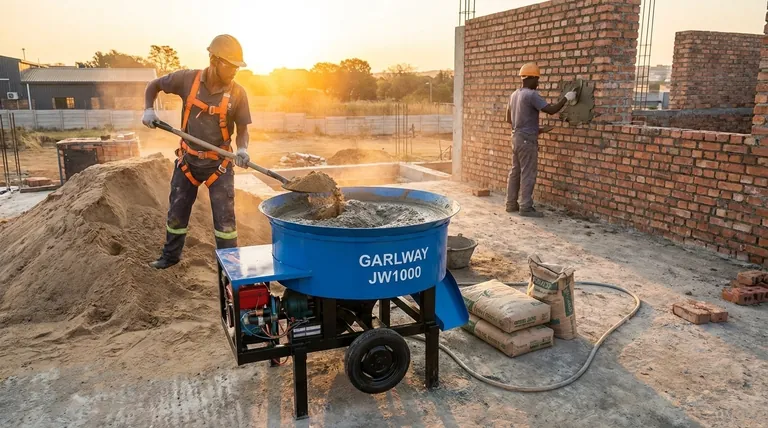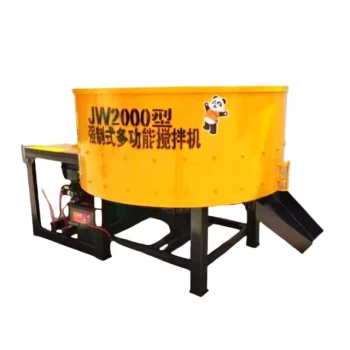Yes, a concrete mixer can be used for mortar, but it's important to understand the compromise you are making. Because mortar lacks the coarse aggregate (gravel) found in concrete, a standard drum-style concrete mixer may not combine the ingredients as effectively as a dedicated mortar mixer or even hand-mixing for smaller batches.
The core issue isn't whether a concrete mixer can mix mortar, but how well it does the job. The tumbling action of a concrete mixer relies on gravel to help combine ingredients, whereas a proper mortar mixer uses paddles to ensure a smooth, consistent blend.

The Difference in Mixing Action
The effectiveness of a mixer comes down to its mechanical design. Concrete mixers and mortar mixers are purpose-built for different materials, and their actions reflect that.
How a Concrete Mixer Works
A standard concrete mixer is a rotating drum with fixed fins inside. It works by tumbling the materials. As the drum turns, it lifts the concrete ingredients—sand, gravel, cement, and water—and lets them fall. The heavy, coarse gravel is critical to this process, acting as a grinding and blending agent that breaks up clumps of cement and ensures a uniform mixture.
How a Mortar Mixer is Different
A mortar mixer, often a horizontal trough, uses a set of rotating paddles. This design doesn't rely on tumbling; it creates a shearing and folding action. The paddles actively force the sand, cement, lime, and water together, which is ideal for creating the smooth, plastic, and sticky consistency required for laying bricks or tiles.
Why This Matters for Your Mortar
When you put mortar ingredients into a concrete mixer, you remove the key element that makes it work: gravel. Without the coarse aggregate, the sand and cement paste can simply slide along the walls of the drum instead of mixing thoroughly. This can result in an inconsistent blend with dry clumps.
Understanding the Trade-offs
Using a concrete mixer for mortar is a practical decision for some scenarios, but it comes with clear disadvantages.
The Case for Using a Concrete Mixer
For large-scale projects, such as building a long block wall, the sheer volume of mortar required can make a concrete mixer a practical choice. It significantly reduces the physical labor and time compared to mixing dozens of batches by hand in a wheelbarrow.
Potential Downsides to Expect
The most common issue is a lower-quality mix. The mortar may not achieve the ideal "buttery" consistency that makes it easy to work with. You may have to stop the mixer periodically to manually scrape the sides and break up clumps to achieve a workable blend.
When Hand-Mixing is the Better Option
For most small-to-medium sized projects—like repointing brickwork, tiling a bathroom, or building a small garden wall—hand-mixing is superior. Mixing in a wheelbarrow or a mortar tub with a hoe gives you complete control over the consistency and is often faster when you factor in setup and cleanup time for a machine.
Making the Right Choice for Your Project
Choosing your mixing method depends entirely on the scale of your work and the quality you require.
- If your primary focus is speed on a very large project: A concrete mixer is a viable tool, but be prepared to monitor the mix closely for consistency.
- If your primary focus is the highest quality finish for masonry: A dedicated paddle-style mortar mixer is the correct professional tool for the job.
- If your primary focus is a small repair or DIY project: Hand-mixing offers the best control and is the most practical and efficient method.
Ultimately, matching the tool to the material is key to achieving a professional and durable result.
Summary Table:
| Mixing Method | Best For | Key Advantage | Potential Drawback |
|---|---|---|---|
| Concrete Mixer | Large-scale projects requiring speed | Reduces manual labor for big batches | Can produce inconsistent, clumpy mortar |
| Mortar Mixer | Professional masonry work | Creates a smooth, "buttery" consistency | Higher cost, specialized tool |
| Hand-Mixing | Small repairs & DIY projects | Total control over consistency | Labor-intensive for large volumes |
Get the Right Mixer for Your Construction Needs
Choosing the correct equipment is crucial for the quality and efficiency of your project. GARLWAY specializes in providing durable and reliable construction machinery, including concrete mixers, mortar mixers, and concrete batching plants, tailored for construction companies and contractors worldwide.
Let us help you select the perfect tool to ensure a professional finish and maximize your productivity. Contact our experts today to discuss your specific requirements and discover how GARLWAY can power your projects.
Visual Guide

Related Products
- Ready Mixer Machine for Construction Ready Mix Machinery
- Commercial Construction Mixer Machine for Soil Cement Mixing Concrete
- Auto Concrete Cement Mixer Machine New
- JDC350 Small Cement Concrete Mortar Mixer
- Construction Products Concrete Plant Machine Mixing Concrete Mixer
People Also Ask
- What should be considered regarding the output of a concrete mixer? Match Capacity to Your Project Scale
- What is the average lifespan of a concrete mixer? Maximize Your Equipment's Lifespan & ROI
- What safety considerations are important for concrete mixer operation? A Guide to Proactive Risk Management
- What is the function of a concrete mixer machine? Achieve Consistent, High-Quality Concrete for Your Projects
- What was significant about Roscoe Lee's 1934 concrete mixer design? Pioneering Modular Construction Equipment



















